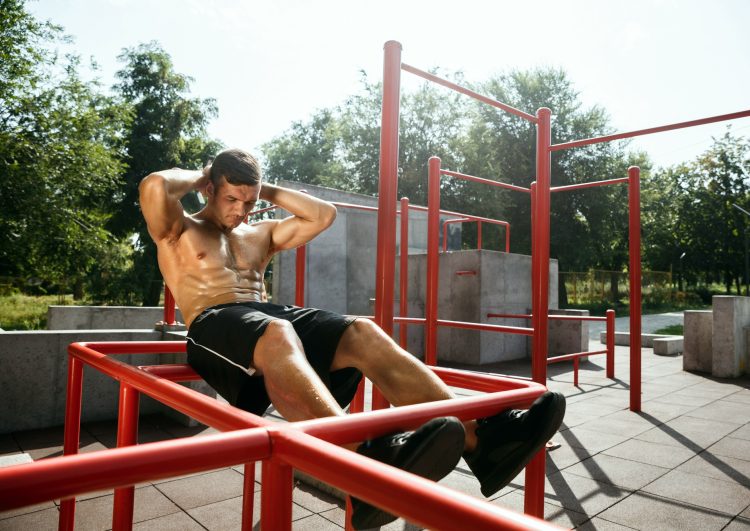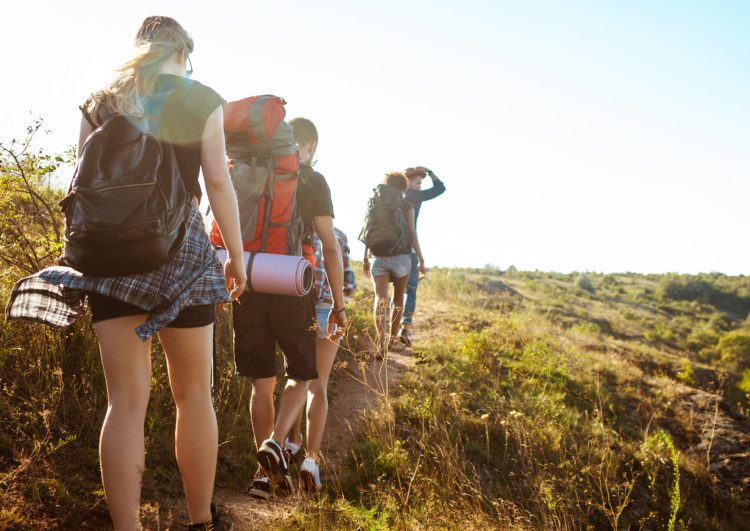Exercise is good for everybody’s body. With a plethora of proven physical and mental benefits, working out will improve your fitness and health and could even help you live longer (1). It’s no exaggeration to say that exercise is “big medicine.”
Most discussions about exercise center on going to a gym. This makes a lot of sense, as gyms contain everything you need for a wide range of workouts. They’re also where you can interact with like-minded people and receive guidance and instruction.
As a personal trainer with several decades of experience, I spend most of my time working in gyms. However, some people find gyms decidedly off-putting. Consequently, I also work with clients in non-gym settings. This includes beaches, parks, playgrounds, and their home.
Reasons for not wanting to go to a gym include:
- Too crowded
- Are often noisy
- Can feel intimidating
- No privacy
- A bad previous experience
- Concerns over cleanliness and hygiene
- Prohibitive cost
- No gyms within easy reach
The good news is that you don’t have to go to a gym if you don’t want to. In fact, you can achieve a high level of fitness by doing “green exercise,” which is another name for outdoor workouts.
In this article, I reveal the benefits of outdoor workouts and explore your green exercise options, season by season.
Level Up Your Fitness: Join our 💪 strong community in Fitness Volt Newsletter. Get daily inspiration, expert-backed workouts, nutrition tips, the latest in strength sports, and the support you need to reach your goals. Subscribe for free!
The Advantages and Benefits of Outdoor Workouts
As the saying goes, the only bad workout is the one you didn’t do. Consequently, all forms of exercise are good for your fitness and health. That said, studies suggest that green or outdoor exercise offers some additional advantages and benefits over gym-based workouts (2, 3). These include:
Advantages:
- Convenience – outdoor spaces are readily accessible, often without the need for membership fees or travel time.
- Lower cost compared to gym memberships or indoor fitness classes.
- You can do outdoor workouts with your partner, family, or friends. Many green workouts are group activities.
- Flexibility to choose from a variety of outdoor environments and activities based on personal preferences and interests.
- Increased motivation and enjoyment compared to indoor exercise routines.
Physical Benefits:
- Improved cardiovascular fitness and health.
- Increased vitamin D production from sunlight exposure.
- Enhanced respiratory health due to fresh air.
- Boosted immune system from exposure to natural elements.
- Potential for higher calorie burn in certain outdoor activities.
- Reduced risk of obesity and related health conditions.
- Enhanced balance, agility, and coordination through varied terrain.
- Improved sleep quality, potentially due to increased exposure to natural light.
Mental Benefits:
- Reduced stress levels and improved mood.
- Enhanced sense of well-being and happiness.
- Decreased symptoms of anxiety and depression.
- Increased self-esteem and confidence.
- Enhanced cognitive function and concentration.
- Boosted creativity and problem-solving skills.
- Increased feelings of relaxation and rejuvenation.
- Enhanced social interaction and community connection.
- Increased mindfulness and appreciation for nature.
While you can achieve some of these benefits with gym workouts, it’s reassuring to know that you can achieve all of them and more by taking your training outdoors.
Outdoor Workouts for Every Season
Have I inspired you to take your workout outdoors and embrace green exercise? Excellent –you won’t regret it! I make a point of exercising outdoors as often as possible, and I can personally attest to the many advantages and benefits.
With that in mind, here is a list of outdoor workouts to try, listed season-by-season.
Spring:
Spring is a great time to get outdoors. The weather is warming up, and nature is waking from its winter slumber. While you may have a few spring showers to contend with, a little rain never hurt anyone and, as we used to say in the Royal Marines, your skin is waterproof!
Hiking
Hiking is a great way to build fitness, endurance, and leg strength. Hills and uneven terrain will challenge your muscles while you soak up the sights and sounds. Make sure you carry plenty of water; hiking can be a very sweaty, dehydrating workout.
Trail running
Running is one of the most accessible and beneficial outdoor workouts. Trail running is especially effective as the hilly and varied terrain will challenge your body in a whole new way. As an added benefit, trial-running scenery is invariably better than you’ll find while running on roads or a treadmill (or “dreadmill,” am I right?!)
Mountain biking
Spring is the perfect time to dust off your mountain bike and head for the hills. Cycling is a low-impact activity that’s easier on your joints than running. Also, you’ll be able to travel further with less effort than hiking. As such, mountain biking is an excellent way to explore new pastures.
Rock climbing
Rock climbing is a great upper body and core workout that also develops balance, mobility, and confidence. Done with ropes, it’s also very safe. Learn the basics in a climbing gym, and then grab your harness and chalk bag and scale the heights outdoors. Alternatively, you can try bouldering, which is a low-altitude form of rock climbing.
Parkour
The great thing about parkour, a.k.a free running, is that you can do it almost anywhere. The aim is to move over, through, or around obstacles in the most efficient way possible. Parkour develops agility, mobility, power, and strength, and it’s also a lot of fun! If you have ever dreamed of being a movie stunt performer, you’ll love parkour.
Outdoor workouts
Whether you want to do calisthenics, HIIT, Pilates, or any other low-tech workout, you can probably do it outdoors. Pack whatever you need in a backpack and head to your local park to enjoy the fresh air and sunshine. Train alone or with your partner or a friend; either way, outdoor exercise is hard to beat.
Geocaching
Geocaching is an outdoor activity where participants use GPS devices to find hidden containers (geocaches). As such, it involves exploring various terrains by walking, hiking, or climbing. Navigating to specific coordinates adds mental engagement and excitement, and geocaching is the ideal fitness activity for the whole family.
Find out more about Geocaching here.
Adventure racing
Adventure races happen throughout the year, but springtime events are often the most popular because the weather is more forgiving. Races vary enormously and can include a wide range of activities, from biking to hiking to rafting. Why not form your friends into a team and race together? Adventure races can be hugely bonding experiences.
Summer:
Summer is the ideal time to enjoy water-based workouts. After all, what’s better on a hot day than a dip in a lake, river, or the sea? However, make sure you respect the power of the sun, use a high-SPF sunscreen, and don’t forget your sunhat and sunglasses.
Beach sports, e.g., soccer, football, volleyball
Round up your friends for a fitness-orientated day at the beach. Play some soccer, touch football, volleyball, or frisbee to build up a sweat and burn some calories. Pounding through the sand reduces impact while increasing resistance, making beach sports a challenging yet enjoyable workout for your legs, heart, and lungs.
Surfing and bodyboarding
When the weather is hot, there is no better place to be than in the water. Surfing and bodyboarding are like interval training, as there are periods of work alternated with periods of rest and recovery. Both surfing and bodyboarding strengthen your upper body and core and are great for balance and agility.
Level Up Your Fitness: Join our 💪 strong community in Fitness Volt Newsletter. Get daily inspiration, expert-backed workouts, nutrition tips, the latest in strength sports, and the support you need to reach your goals. Subscribe for free!
Wild swimming
Wild swimming refers to swimming in rivers, lakes, or the ocean or, in other words, not being in a pool. Swimming is a low-impact activity that works your heart, lungs, and all major muscles. Wild swimming means you are more likely to see fish and aquatic plant life, making it much more engaging than staring at the bottom of a pool.
Rollerblading and skateboarding
Why walk or run when you can roll?! Rollerblading and skateboarding are fast-paced and fun, although they are not necessarily the most straightforward skills to master. However, learning to rollerblade or skateboard is hugely rewarding and will do wonders for your balance and agility.
Kayaking, canoeing, or stand-up paddleboarding (SUP)
Kayaking, canoeing, and paddleboarding offer many similar benefits. They challenge your upper body, core, and balance and provide a great way to see the shoreline from a new perspective. Kayaking and canoeing are easier to learn, while paddleboarding provides more of a full-body workout. Try them all to see which one you prefer.
Outdoor yoga
Hot or Bikram yoga is very popular. Doing yoga in a warm environment enhances flexibility and mobility and also increases the cardiovascular demands of your workout. But you don’t need to go to a hot yoga studio – just head outdoors and enjoy the natural warmth of the sun. Just remember your sunscreen so you don’t come home with sunburn.
Beach workouts
Like parks, beaches are a great place to work out. Running and sprinting on the beach are particularly challenging, especially where the sand is loose. Head for the dunes for an even more intense workout. Do push-ups, squats, lunges, and any of your other favorite bodyweight exercises. End your session with a cooling swim in the sea.
Beach clean-up hikes
Grab an empty trash bag and go for a walk along the shoreline, picking up any trash you find. This workout will help you clock up lots of steps and also involves lots of squatting, bending, and hip hinging. Good for you, and good for the environment – what’s not to love?!
Fall:
If you enjoy spending time in nature, you’ll probably love fall. Temperatures are generally lower and more comfortable, and the leaves start turning a beautiful golden brown. This is the perfect time to head to the woods and witness the majesty of Mother Nature.
Hiking among fall foliage
Hiking is a year-round fitness activity, but fall is arguably the best time in terms of weather, temperature, and scenery. Leaves are starting to turn brown, and cooler temperatures and a little more rain mean that nature is thriving after the heat of summer. Make your hike more challenging by strapping on your weighted vest and doing some rucking.
Canopy tours/ziplining
Get up in the branches and see the ground from above with an organized tree canopy and ziplining tour. While this workout will test your head for heights, it’ll also develop your confidence and agility. Don’t worry; you’ll be roped in, so despite scaling the heights, canopy tours and ziplining are very safe.
Pumpkin patch workouts
Fall means Halloween, and that means pumpkins. As well as making great jack-o-lanterns and being nutritious and tasty, pumpkins are ideal for strength training. So, head to the pumpkin patch and do some goblet squats, overhead presses, rows, and curls. However, pumpkin slams are not one of my recommended exercises!
Obstacle courses
Obstacle races are very popular during the fall. Lower temperatures make them safer and more enjoyable, and some rain means the obstacles are more challenging to overcome, which makes the organizers and participants happy. Enter a race alone or compete as a team. Either way, a fall obstacle race could be one of the highlights of your fitness year.
Orienteering
If you like running and can read a map, you’ll probably enjoy orienteering. This activity involves navigating a route while passing through numerous checkpoints on your map. While speed matters, so too does your map reading ability. Miss a checkpoint, and you’ll be penalized. Think of orienteering as the thinking person’s version of trail running.
Road cycling
Avoid the mud that often accompanies fall, and take your bike out on the roads. Road cycling usually means faster speeds and longer distances, so it’s a great way to explore. Try to stick to quiet, well-maintained roads so you can focus on pushing the pace and getting a great cardiovascular workout.
Winter:
Backcountry skiing and snowboarding
While downhill skiing and snowboarding are a lot of fun, heading off-piste and into the backcountry is the best way to avoid the crowds and get a better workout. Carving your own trial is much more challenging than sticking to a prepared run. However, make sure you carry a GPS locator in case you run into trouble far from civilization and need help.
Ice skating
Ice skating is a very effective leg and cardio workout that’s also great for your balance. There are several ways to enjoy an ice-skating workout, including ice hockey, speed skating, and skate touring. Just make sure the ice is strong enough to support your weight. Seek advice if you are unsure whether it is safe to skate.
Snowshoeing
Running and hiking in deep snow is very challenging, if not impossible. However, strap on a pair of snowshoes, and you’ll have no problem crossing the deepest snowfields. Snowshoeing is a wonderful way to enjoy the beauty of winter while still getting plenty of miles under your belt.
Ice climbing
Ice climbing involves using ice axes and crampons to scale frozen waterfalls. Like regular climbing, this provides an excellent workout for your upper body and core. Many rock climbers turn to ice climbing in the winter when most crags are inaccessible or unclimbable due to the wintery conditions.
Sledding
Are you looking for a fun fitness activity you can do with your family and friends? Try sledding. Dragging your sled up a hill and then riding it back down is a form of interval training, which is one of the most effective and efficient workouts around. However, you’ll probably be too busy enjoying yourself to notice how hard you are working.
Snow shoveling
Get a workout while doing some chores with snow shoveling. Clearing snow is a tremendous full-body workout; just a few minutes will leave you warm and out of breath. Shoveling snow is also an excellent calorie burner. So, don’t just clear your drive, but offer to do your neighbors too – all in the name of fitness and fat loss.
Closing Thoughts
While I have nothing against gym-based workouts, I usually prefer to train outdoors. I find activities like hiking and paddleboarding much more enjoyable than gym training, and I appreciate the benefits of spending time in nature.
I even have an outdoor gym at home comprising a pull-up bar, gymnastics rings, dip bars, and a couple of rusty kettlebells. While this setup is very basic, it’s enough to provide a well-balanced workout. Plus, I get to train in the fresh air and the sunshine, which is always very welcome.
Gym workouts are effective, but they’re not for everyone. That said, you don’t have to let your dislike of the gym stop you from exercising. Try the outdoor workouts listed in this article to get fit in nature, whatever the season.
Do you have a question about outdoor exercise? Or do you want to share your favorite outdoor workout? Drop me a line in the comments section below, and I’ll get back to you ASAP!
References:
- Wang Y, Ashokan K. Physical Exercise: An Overview of Benefits From Psychological Level to Genetics and Beyond. Front Physiol. 2021 Aug 12;12:731858. doi: 10.3389/fphys.2021.731858. PMID: 34456756; PMCID: PMC8397487.
- Gladwell VF, Brown DK, Wood C, Sandercock GR, Barton JL. The great outdoors: how a green exercise environment can benefit all. Extrem Physiol Med. 2013 Jan 3;2(1):3. doi: 10.1186/2046-7648-2-3. PMID: 23849478; PMCID: PMC3710158.
- Lahart I, Darcy P, Gidlow C, Calogiuri G. The Effects of Green Exercise on Physical and Mental Well-being: A Systematic Review. Int J Environ Res Public Health. 2019 Apr 15;16(8):1352. doi: 10.3390/ijerph16081352. PMID: 30991724; PMCID: PMC6518264.













